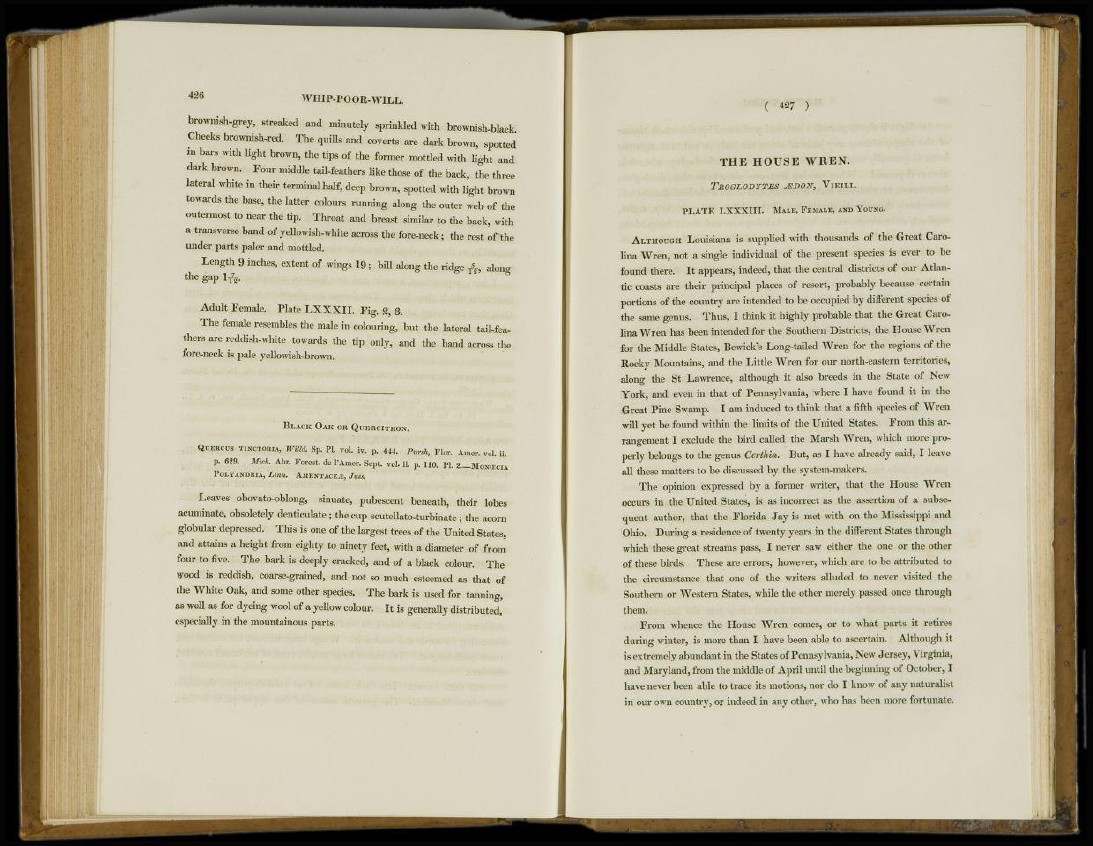
426 WHIP-POOR-WILL.
brownish-grey, streaked and minutely sprinkled with brownish-black.
Cheeks brownish-red. The quills and coverts are dark brown, spotted
in bars with light brown, the tips of the former mottled with light and
dark brown. Four middle tail-feathers like those of the back, the three
lateral white in their terminal half, deep brown, spotted with light brown
towards the base, the latter colours running along the outer web of the
outermost to near the tip. Throat and breast similar to the back, with
a transverse band of yellowish-white across the fore-neck; the rest of the
under parts paler and mottled.
Length 9 inches, extent of wings 19; bill along the ridge T
5 2 , along
the gap 1TV
Adult Female. Plate LXXXII. Fig. 2, 3.
The female resembles the male in colouring, but the lateral tail-feathers
are reddish-white towards the tip only, and the band across the
fore-neck is pale yellowish-brown.
BLACK OAK OR QUERCITRON.
QUERCUS TINCTORIA, Willd. Sp. PL voL iv. p. 444. Pursh, Flor. Amer. vol. ii.
p. 629. Mich. Abr. Forest. <le l'Ainer. Sept. vol. iL p. 110. PL 2 MONOICIA
POLYANDRIA, Linn. AMENTACE^E, JUSS.
Leaves obovato-oblong, sinuate, pubescent beneath, their lobes
acuminate, obsoletely denticulate ; the cup scutellato-turbinate ; the acorn
globular depressed. This is one of the largest trees of the United States,
and attains a height from eighty to ninety feet, with a diameter of from
four to five. The bark is deeply cracked, and of a black colour. The
wood is reddish, coarse-grained, and not so much esteemed as that of
the White Oak, and some other species. The bark is used for tanning,
as well as for dyeing wool of a yellow colour. It is generally distributed,
especially in the mountainous parts.
THE HOUSE WREN.
TROGLODYTES JEDON, VIEILL.
P L A T E L X X X I I I . MALE, FEMALE, AND YOUNG.
ALTHOUGH Louisiana is supplied with thousands of the Great Carolina
Wren, not a single individual of the present species is ever to be
found there. It appears, indeed, that the central districts of our Atlantic
coasts are their principal places of resort, probably because certain
portions of the country are intended to be occupied by different species of
the same genus. Thus, I think it highly probable that the Great Carolina
Wren has been intended for the Southern Districts, the House Wren
for the Middle States, Bewick's Long-tailed Wren for the regions of the
Rocky Mountains, and the Little Wren for our north-eastern territories,
along the St Lawrence, although it also breeds in the State of New
York, and even in that of Pennsylvania, where I have found it in the
Great Pine Swamp. I am induced to think that a fifth species of Wren
will yet be found within the limits of the United States. From this arrangement
I exclude the bird called the Marsh Wren, which more properly
belongs to the genus Certhia. But, as I have already said, I leave
all these matters to be discussed by the system-makers.
The opinion expressed by a former writer, that the House Wren
occurs in the United States, is as incorrect as the assertion of a subsequent
author, that the Florida Jay is met with on the Mississippi and
Ohio. During a residence of twenty years in the different States through
which these great streams pass, I never saw either the one or the other
of these birds. These are errors, however, which are to be attributed to
the circumstance that one of the writers alluded to never visited the
Southern or Western States, while the other merely passed once through
them.
From whence the House Wren comes, or to what parts it retires
during winter, is more than I have been able to ascertain. Although it
is extremely abundant in the States of Pennsylvania, New Jersey, Virginia,
and Maryland, from the middle of April until the beginning of October, I
have never been able to trace its motions, nor do I know of any naturalist
in our own country, or indeed in any other, who has been more fortunate.